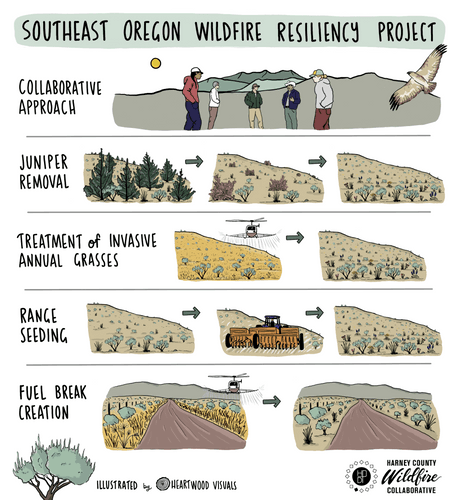Building Wildfire Resilience
Building Wildfire Resiliency in a Wilderness Study Area
The southwestern flanks of the Pueblo Mountains are of high ecological value and are a designated Wilderness Study Area. It's this region, that through the collaborative process, partners determined steps to take to increase the wildfire resiliency of this landscape. Watch the video below to learn more about this project.
Building Wildfire Resiliency on a Vast Landscape with a Mix of Private and Agency Ownership.
Building from the work in the Pueblo Mountains the collaborative is also working in a landscape in the Stinkingwater Mountains. The Stinkingwater Mountains Restoration & Fire Resilience Project is vast encompassing 312,000 acres close to Burns and Crane and includes a mix of private land and Bureau of Land Management acreage. On this vast landscape HCWC is working to coordinate actions among the Bureau of Land Management, Natural Resource Conservation Service and private landowners to improve the wildfire resiliency of this landscape. Check out this fact sheet about this project and for more information there are several articles on this collaborative's Resources page.

A Boost to Building Wildfire Resiliency
February of 2022 wildfire resiliency in southeast Oregon got a boost with an investment of $5 million from the Oregon Department of Forestry and Senate Bill 762 for a project the partners defined as the Southeast Oregon Wildfire Resiliency Project. This project compliments work already happening through the Stinkingwater Mountains Restoration & Fire Resilience Project and according to Autumn Muir who coordinates the Stinkingwater subcommittee of the Harney County Wildfire Collaborative shared: "This funding increases the scale of work that can happen to help the Harney County Wildfire Collaborative partners reach a goal of building a wildfire resilient landscape. Just as wildfire knows no boundaries this work is impacting public, private and tribal lands while feeding the economies of small frontier communities in southeast Oregon."
Mid 2023 the door was opened to apply for additional funding which enabled round two of the SOWR project to be implemented; as a result of the application, $3.8 million came into Harney and Malheur Counties. With this funding the Harney County Wildfire Collaborative partners implemented wildfire resiliency treatments on an additional 22,000 acres of public and private land in southeast Oregon beginning this year and into 2025.
Southeast Oregon Wildfire Resiliency Project by the Numbers
- 103,711 Total acres treated
- 12,648 Juniper acres cut and piled
- 1,800 acres seeded with native seed
- 91, 674 acres of invasive annual grasses sprayed
- 120 miles of roadside fuel breaks created
Elevating The Value Of Rangeland Fire Protection Associations
HCWC has worked hard over the years to build strong relationships between collaborative partners, allowing the group to more effectively address suppression of large wildfires. One example, partners saw the importance of greater cohesion between the different agencies responsible for fighting fires, and specifically identified the need to increase Rangeland Fire Protection Associations’ (RFPA) involvement in the fire management process in Harney County. As a direct result of the wildfire collaborative, a RFPA liaison position was created within the Burns Interagency Fire Zone. This position works directly with the RFPAs to meet training and equipment needs, as well as engaging overhead teams during large fires. The 2019 fire season proved a model example for how collaborative efforts enable seamless coordination thanks to the relationships built and work that is put in before the fire season begins. Read this downloadable article, Cooperative Partnerships Highlight The 2019 Fire Season, which can be found on the HCWC Resources page.

